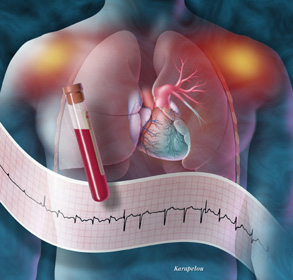导读:最近英德两国科学家发表在《临床研究杂志》上的一项研究称,一种名为Popdc的蛋白在促使心率加速过程中起着关键作用,这种蛋白会对肾上腺素信号作出反应,从而使心脏能够在面对压力时产生正确的应激反应。

当面对压力或刺激时,人体会分泌大量的肾上腺素,加速心跳频率,促进血液流动,为身体提供更多能量。到目前为止,学界对肾上腺素加速心跳频率的机制还不十分清楚。最近英德两国科学家发表在《临床研究杂志》上的一项研究称,一种名为Popdc的蛋白在促使心率加速过程中起着关键作用,这种蛋白会对肾上腺素信号作出反应,从而使心脏能够在面对压力时产生正确的应激反应。
该项研究由英国伦敦帝国理工大学、伯明翰大学以及德国维尔兹堡大学的研究人员合作完成。他们针对小鼠的研究发现,在缺乏Popdc蛋白的情况下,小鼠在面对压力时,其心率不会加快。这与健康小鼠的应激反应完全不同,后者会在肾上腺素增多时心跳频率加快,以保证体内的氧气供应。
Popdc蛋白位于心脏起搏细胞外膜,其被发现已有十年,因大量存在于肌肉组织中,因此这种蛋白也被称作“大力水手”蛋白。研究人员发现,Popdc蛋白会对肾上腺素发出的信号分子作出反应,进而改变细胞膜的电特性。研究人员认为这正是肾上腺素影响心跳频率的机制。
许多老年人在面对压力时常会出现心律失常的状况,并可能患上病窦综合征,这意味着他们需要安装人工起搏器。造成这种状况的原因科学家们并不十分清楚。对此,领导该研究的伦敦帝国理工大学的托马斯·布兰德教授表示,针对小鼠的新研究表明,Popdc蛋白在调节心率方面起着重要作用,而同样情况也适用于人类。进一步的研究将会提供更多有关心律失常病因的线索,从而帮助科学家研发新的药物和疗法,以应对如病窦综合征、房颤等心率失常疾病。

 Popeye domain containing proteins are essential for stress-mediated modulation of cardiac pacemaking in mice
Popeye domain containing proteins are essential for stress-mediated modulation of cardiac pacemaking in mice
Alexander Froese, Stephanie S. Breher, Christoph Waldeyer, Roland F.R. Schindler, Viacheslav O. Nikolaev, Susanne Rinné, Erhard Wischmeyer, Jan Schlueter, Jan Becher, Subreena Simrick, Franz Vauti, Juliane Kuhtz, Patrick Meister, Sonja Kreissl, Angela Torlopp, Sonja K. Liebig, Sandra Laakmann, Thomas D. Müller, Joachim Neumann, Juliane Stieber, Andreas Ludwig, Sebastian K. Maier, Niels Decher, Hans-Henning Arnold, Paulus Kirchhof, Larissa Fabritz and Thomas Brand
Cardiac pacemaker cells create rhythmic pulses that control heart rate; pacemaker dysfunction is a prevalent disorder in the elderly, but little is known about the underlying molecular causes. Popeye domain containing (Popdc) genes encode membrane proteins with high expression levels in cardiac myocytes and specifically in the cardiac pacemaking and conduction system. Here, we report the phenotypic analysis of mice deficient in Popdc1 or Popdc2. ECG analysis revealed severe sinus node dysfunction when freely roaming mutant animals were subjected to physical or mental stress. In both mutants, bradyarrhythmia developed in an age-dependent manner. Furthermore, we found that the conserved Popeye domain functioned as a high-affinity cAMP-binding site. Popdc proteins interacted with the potassium channel TREK-1, which led to increased cell surface expression and enhanced current density, both of which were negatively modulated by cAMP. These data indicate that Popdc proteins have an important regulatory function in heart rate dynamics that is mediated, at least in part, through cAMP binding. Mice with mutant Popdc1 and Popdc2 alleles are therefore useful models for the dissection of the mechanisms causing pacemaker dysfunction and could aid in the development of strategies for therapeutic intervention.







